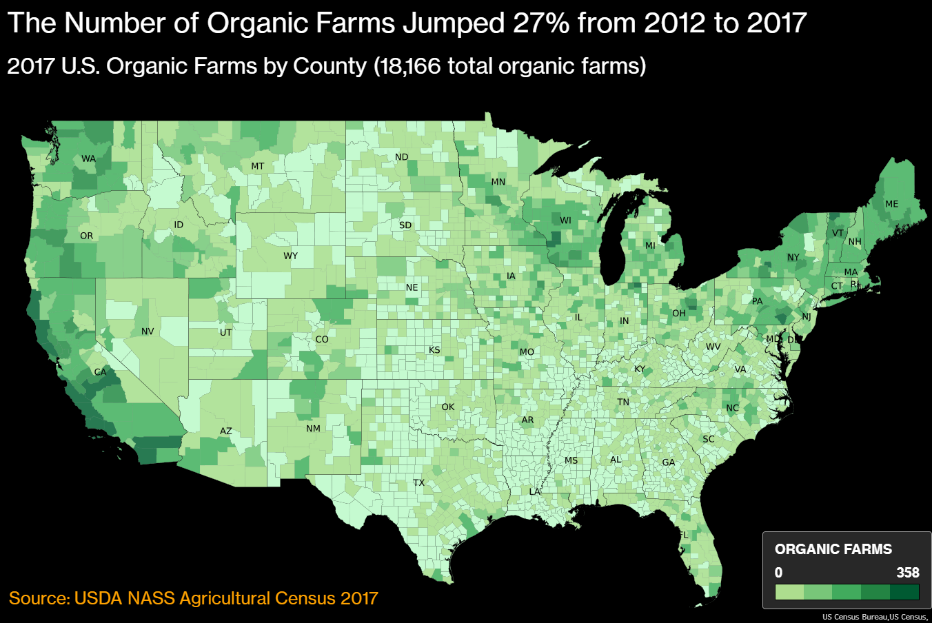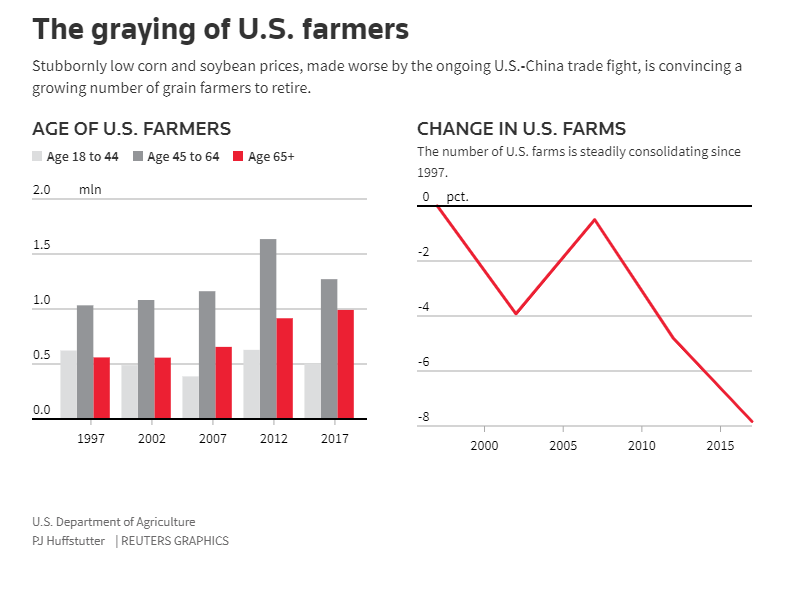21
May
Organic Agriculture is Growing as Chemical-Intensive Farming Struggles

(Beyond Pesticides, May 21, 2019) As farmers nationwide are facing extreme stressors and either consolidating or retiring, organic is going against the grain. Despite overall declines in the number of U.S. farms, the number of organic farms increased 27% between 2012 and 2017, according to new data from the USDA National Agricultural Statistics Service.
The value of organic sales in 2017 was $7.2 billion, and the average value of sales per farm has increased a remarkable 84% since 2012. Laura Batcha, the executive director of the Organic Trade Association, told Bloomberg that young families are among the drivers in the organic market as they seek to avoid residues of chemicals, antibiotics, and hormones on food.
Organic products fetch a higher price point than conventional. Indiana farmer Joe Mills can sell his organic food-grade corn for about $10.50 a bushel, while chemical-intensive sells for about $3.50/bushel. Mr. Mills notes, “Yes, it’s economical, but there is a huge learning curve and a mindset change. We relied on commercial fertilizers and pesticides for so long.” At the same time, the benefits and affordability of organic food are critical to the market, as consumers consider their purchasing choices. Read the Beyond Pesticides’ report Low Food Prices: The Real Story on the Affordability of Organic Food.
Many farmers, faced with five years of low commodity prices and an onslaught of problems, are experiencing unsustainably low income. Extreme weather and shifting climate are rapidly increasing—these are devastating threats for under-protected and economically vulnerable farms.
Even before the mass flooding of the Midwest earlier this year, net farm income had fallen nearly 50% since 2013. Trump administration trade tariffs have exacerbated the problem; the trade war with China has lasted nearly ten months and is having a significant impact on producers. In the first quarter of 2019, farm income declined by $11.8 billion. Farm debt has increased rapidly, reaching levels last seen during the 1980’s. Soybeans are the most valuable U.S. agricultural export, and China is the country’s number one buyer. China has drastically reduced its purchases of American exports and, as the trade war escalates, there is evidence that they may stop purchasing agricultural products altogether.
Experts are concerned about the mental health of farmers and farmworkers, who have a statistically higher suicide rate than other occupations. The flooding situation is especially dire, as the Chicago Tribune explains: “Now, the floods may have stripped many farmers’ land of the soil it needs to grow crops, which could take years to return to production. Some farmers have been storing grain for several years in anticipation of better prices, but floodwaters eroded their land and contaminated the grain. Neither USDA disaster programs nor insurance policies cover stored grain. Crop insurance may cover inputs, such as chemical and fertilizer, but it won’t provide additional income to support households.”
As an aging farming population assesses the current troubles and their return on investment, many are choosing to retire. In contrast, organic producers are generally younger and more likely to be full-time farmers. 17% of organic producers are age 34 or less, more than double the number in the same age bracket for all farms (8%).

In a time of economic and environmental upset, organic agriculture is a viable commercial alternative that can help to mend the planet through carbon sequestration, and elimination of water, air, and soil contamination associated with pesticide and synthetic fertilizer use. U.S. Representative Chellie Pingree wrote for Civil Eats, “…in our new push for climate solutions—from the ambitious Green New Deal to our recommitment to the Paris Agreement—farmers and ranchers need to have a seat at the table.” While food production contributes approximately a quarter of annual greenhouse gases, “Those who produce our food also hold the potential to reverse that statistic,” Rep. Pingree said.
Organic farms will also be more resilient to the threats of a changing climate: healthy soil and soil cover help prevent nutrient and water loss, making them better prepared to withstand floods and droughts. The Rodale Institute reports that organic plots produce yields up to 40% higher than chemically-intensive plots in times of drought because and organic soil system retains more water.
Now, more than ever, it is critical to invest in America’s organic farms—not only is it a good financial decision, it could help save the planet. See Beyond Pesticides’ extensive resources on organic for more.
All unattributed positions and opinions in this piece are those of Beyond Pesticides.
Sources: Bloomberg, Chicago Tribune, Reuters, Civil Eats










